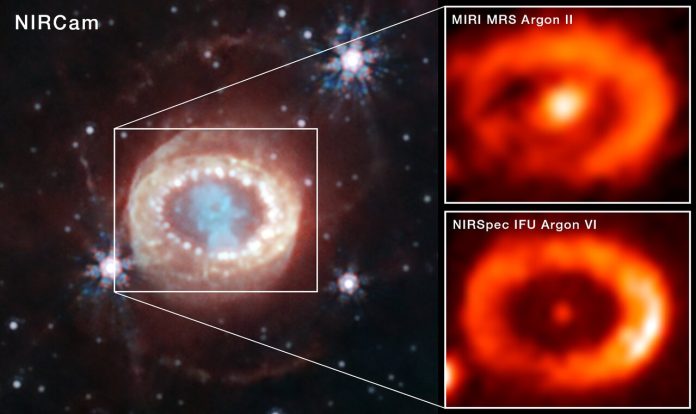In a study reported recently, astronomers observed the SN 1987A remnant using Telescopul spațial James Webb (JWST). The results showed emission lines of ionized argon and other heavily ionised chemical species from the centre of the nebula around SN 1987A. Observation of such ions means presence of a newly born neutron stea as the source of high energy radiation at the centre of the supernova remanent.
Stele are born, age and finally die with an explosion. When the fuel runs out and nuclear fusion in the core of star ceases, the inward gravitational force squeezes the core to contract and collapse. As the collapse begins, in few milliseconds, the core gets so compressed that electrons and protons combine to form neutrons and a neutrino is released for each neutron formed. In the case of stele supermasive,nucleul se prăbușește într-un interval scurt de timp cu o explozie puternică, luminoasă numită Supernova. The burst of neutrinos produced during core-collapse escape into outer spaţiu unimpeded due to its non-interactive nature with matter, ahead of photons which are trapped in the field, and acts as a beacon or an early warning of a possible optical observation of supernova explosion soon
SN 1987A was the last supernova event seen in southern sky in February 1987. It was the first such supernova event visible to the naked eye since Kepler’s in 1604. Located 160 000 light-years from Earth in the nearby Large Magellanic Cloud (a satellite galaxie of the Milky Way), it was one of the brightest exploding stars seen in more than 400 years that blazed with the power of 100 million suns for several months and provided unique opportunity to study the phases before, during, and after the death of a stea.
The SN 1987A was a core-collapse supernova. The explosion was accompanied by neutrino emission which was detected by two water Cherenkov detectors, Kamiokande-II and the Irvine-MichiganBrookhaven (IMB) experiment about two hours prior to the optical observation. This suggested that a compact object (a neutron star or gaură neagră) should have formed after core collapse, but no neutron star following SN 1987A event or any other such recent supernova explosion was ever directly detected. Though, there is indirect evidence for presence of a neutron star in the remanent.
In a study reported recently, astronomers observed the SN 1987A remnant using Telescopul spațial James Webb (JWST). The results showed emission lines of ionized argon and other heavily ionised chemical species from the centre of the nebula around SN 1987A. Observation of such ions means presence of a newly born neutron star as the source of high energy radiation at the centre of the supernova remanent.
Este pentru prima dată când au fost detectate efectele emisiei de energie înaltă de la tânăra stea neutronică.
***
Surse:
- Fransson C., et al 2024. Linii de emisie datorate radiațiilor ionizante de la un obiect compact din restul Supernovai 1987A. ŞTIINŢĂ. 22 februarie 2024. Vol 383, Issue 6685 pp. 898-903. DOI: https://doi.org/10.1126/science.adj5796
- Universitatea din Stockholm. Știri - Telescopul James Webb detectează urme de stele neutroni în supernova emblematică. 22 februarie 2024. Disponibil la adresa https://www.su.se/english/news/james-webb-telescope-detects-traces-of-neutron-star-in-iconic-supernova-1.716820
- ESA. News-Webb găsește dovezi pentru o stea neutronică în inima rămășiței tinere de supernova. Disponibil la https://esawebb.org/news/weic2404/?lang
***






































